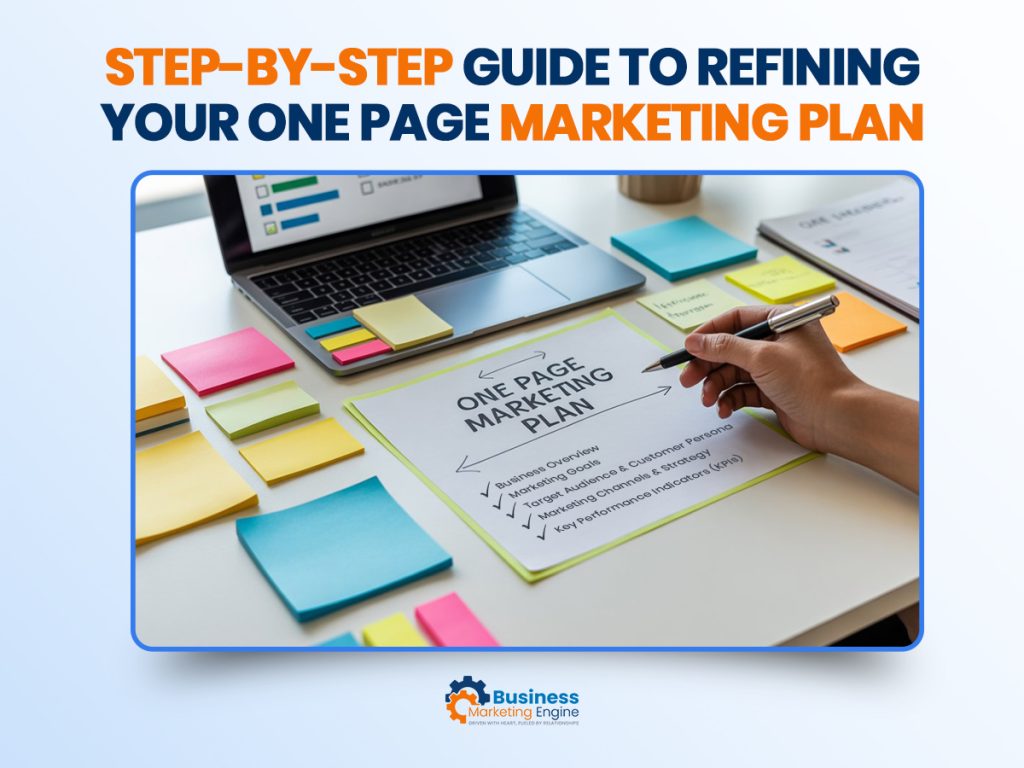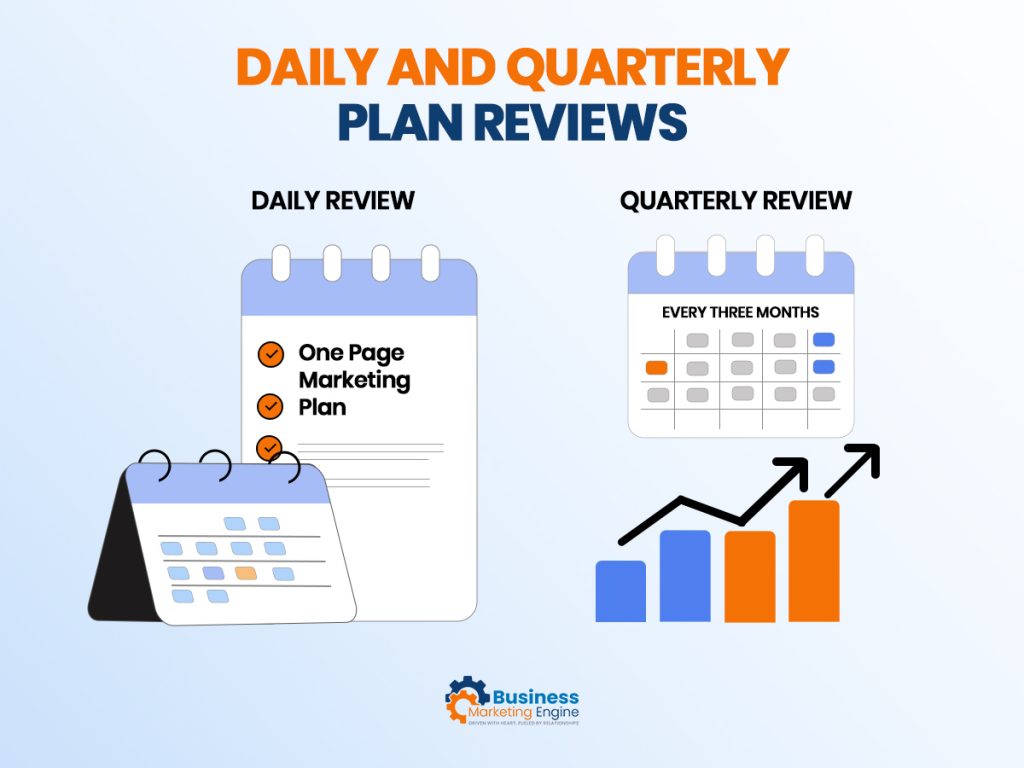Is your one page marketing plan falling short of expectations?
A well-crafted plan can streamline your marketing strategy and help grow your business, but only if it’s done right! Small mistakes can quickly make it ineffective.
In this blog, we’ll walk you through the most frequent marketing mistakes and how to avoid them. By addressing these pitfalls, you can refine your approach, improve results, and ensure your one page marketing plan works long-term.
Unsure what a one page marketing plan should look like for your business? Be sure to check out our last blog, “Crafting A One Page Marketing Plan For Your Local Business.“
The Biggest Marketing Mistakes to Avoid
Mistake #1 – Being Too Vague or Generic
Many businesses make the mistake of not defining a clear target audience or Unique Selling Proposition (USP) in their marketing. While it can be easier to keep things broad, it’s also ineffective.
The Impact:
Without specifics, your marketing messages won’t connect with the right people. You’ll be casting a wide net, but it won’t land you the right customers, and your efforts could feel wasted.
How to Fix It:
To make your one page marketing plan work, get specific! Define who your ideal customer is—this is called creating a customer persona. A customer persona is a detailed description of your ideal customer, including things like their age, interests, challenges, and goals.
Also, make sure you’ve defined your Unique Selling Proposition (USP)—this is what sets you apart from your competition. Whether it’s your product quality, customer service, or unique features, make sure your USP is clear and focused.
The more specific you are, the easier it is to create marketing that resonates with the right audience!
Mistake #2 – Setting Unrealistic or Undefined Goals
Another common pitfall is setting marketing goals that are either too vague or unrealistic. For example, saying “I want to grow my business” is great, but it’s not a goal you can work toward.
The Impact:
When marketing goals aren’t clearly defined or achievable, you end up without a clear direction. This makes it difficult to measure success or adjust your marketing strategy when things aren’t working.
How to Fix It:
Use the SMART goal framework—Specific, Measurable, Achievable, Relevant, and Time-bound—to set goals. For example, instead of saying “increase sales,” set a goal like “Increase sales by 15% within the next 6 months by attracting 30 new leads per month.”
This goal is clear, achievable, and measurable, making it easy to track your progress and adjust when needed. By setting realistic and clear marketing goals, you’ll have a clear roadmap for success!
Mistake #3 – Ignoring Data and Analytics
It’s tempting to create your one page marketing plan based on assumptions or gut feelings rather than data. However, that can lead to costly marketing mistakes and hinder business growth.
The Impact:
When you don’t use data, you risk wasting time and money on strategies that don’t actually bring results. You might invest in the wrong tactics or miss opportunities to improve your efforts.
How to Fix It:
To avoid this, start tracking key performance indicators (KPIs) like engagement rates, conversion rates, and customer acquisition costs. These numbers give you a clear picture of what’s working and what’s not.
There are also plenty of simple tracking tools—like Google Analytics or even social media insights—that can help you measure success.
By using data to guide your decisions, you’ll be able to focus your marketing efforts where they really count.
Mistake #4 – Not Identifying the Right Marketing Channels
A common mistake is trying to be everywhere—posting on every social media platform and running ads everywhere. But trying to reach everyone often means reaching no one.
The Impact:
When you spread your resources too thin, it’s easy to fail at connecting with your ideal audience. You’ll waste time, money, and energy without seeing results.
How to Fix It:
Instead of trying to be everywhere, focus on the platforms where your ideal customers are most active. Whether it’s social media, email marketing, or local SEO, choose the channels that provide the highest return for your business.
For example, if you run a gym, Instagram and local search might be most effective. By focusing your efforts, you can invest more strategically and achieve better results.
Mistake #5 – Neglecting the Competitive Landscape
A lot of businesses fail to research what their competitors are doing. Or, they don’t take the time to differentiate themselves in the market. It’s easy to get caught up in your own business without paying attention to the bigger picture.
The Impact:
When you ignore your competitors, you risk blending into the market rather than standing out. Without a clear understanding of what makes you different, it’s harder for prospects to see why they should choose you.
How to Fix It:
Take time to conduct a simple competitor analysis. Look at what your competitors are offering, and find your unique edge. Are you faster, more affordable, or do you offer a product no one else has?
Once you know what sets you apart, adjust your messaging to clearly highlight that difference. This will help you carve out your own space and attract the right audience.
Mistake #6 – Not Reviewing and Updating the Plan Regularly
A one-page marketing plan isn’t a “set and forget” document. Just because you’ve written it down doesn’t mean it should stay static. The market is always changing, and so should your plan.
The Impact:
If you don’t review and update your plan regularly, your strategies will quickly become outdated. You’ll also miss out on new opportunities, because what worked last year might not work today.
How to Fix It:
Make reviewing your one page marketing plan a habit by scheduling quarterly reviews. During these reviews, assess what’s working, and make adjustments based on real-time feedback and performance data.
By keeping it dynamic, you’ll stay ahead of trends and ensure your marketing efforts stay effective as your business grows.
Step-by-Step Guide to Refining Your One Page Marketing Plan
How to Structure Your One Page Marketing Plan
Your one page marketing plan should focus on the essentials, keeping things simple but impactful. Here are the key components every marketing plan should have:
- Business Overview
Define your business purpose in one sentence. Keep it simple and clear—what do you do, and why does it matter?
- Marketing Goals
Set short-term and long-term goals using the SMART framework. For example, increase foot traffic by 20% (short-term) or build a loyal customer base through a membership program (long-term).
- Target Audience & Customer Persona
Create a customer persona based on demographics, pain points, and needs. Know exactly who you’re targeting and why they matter to your business.
- Marketing Channels & Strategy
Select the platforms and methods you’ll use to reach your audience. Focus on 2-3 channels where your audience spends time, like social media or email marketing. Stay focused to avoid spreading yourself too thin.
- Competitive Advantage & USP
Define what makes your business stand out—whether it’s unique customer service, products, or a local reputation. Your USP should clearly set you apart from your competitors.
- Key Performance Indicators (KPIs)
Identify metrics like traffic, conversion rates, and engagement to track progress and adjust your strategy as needed.
Daily and Quarterly Plan Reviews
Once you’ve structured your one-page marketing plan, it’s essential to use it regularly to guide your actions.
Daily Reviews: Take a few minutes each day to review your one-page plan. This keeps your marketing goals top of mind and helps ensure your actions align with your strategy.
Quarterly Reviews: Set reminders every 3 months to review and adjust your plan. Look at what’s working, make necessary tweaks, and update based on any shifts in the market or your business goals. This helps you stay on track and pivot when necessary.
By keeping your plan simple and revisiting it regularly, you’ll ensure your marketing efforts are focused and effective.
Conclusion
A well-structured, focused one page marketing plan is key to driving business growth! It simplifies your strategy, keeps you on track, and ensures you’re making the most out of your marketing efforts. Take the time to audit your plan for mistakes and make the necessary improvements to strengthen your approach.
If you need any support, reach out! Our senior strategists are here to help fine-tune your strategy and get you the results your business deserves.






